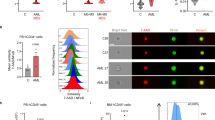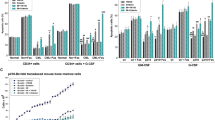Abstract
Blast cell survival in suspension culture is associated with chemoresistance in acute myeloid leukaemia (AML). Autonomous production of IL-1β by AML blasts is linked with a proliferative response, although its role in survival and hence apoptosis-resistance has not been examined in this disease. Cells that secreted more than 19.7 pg/ml IL-1β were significantly more resistant to spontaneous apoptosis in 48-h culture than those that produced less than 19.7 pg/ml IL-1β (P=0.008). Exogenous rhIL-1β significantly enhanced 48-h survival in 25/29 blast cell samples (P=0.0001). IL-1 receptor ligation is known to activate at least three survival pathways: those mediated by PI-3 kinase, IL-1 receptor-associated kinase (IRAK) and ceramidase. In apoptosis-sensitive AML blasts with a strong survival response to rhIL-1β, inhibitors of all three pathways down-modulated an IL-1β-mediated increase in blast survival, but only the inhibition of all three pathways totally eliminated viable blasts. In apoptosis-resistant and apoptosis-sensitive primary AML samples, the three inhibitors all increased apoptosis in vitro after 48 h. Exogenous rhIL-1β induced the hyperphosphorylation of Bcl-2. It also increased the activation of NF-κB in 5/15 blast samples. IL-1β-mediated survival pathways may be a factor in apoptosis-resistance in primary AML blasts, and may therefore contribute to chemoresistance.
This is a preview of subscription content, access via your institution
Access options
Subscribe to this journal
Receive 12 print issues and online access
$259.00 per year
only $21.58 per issue
Buy this article
- Purchase on Springer Link
- Instant access to full article PDF
Prices may be subject to local taxes which are calculated during checkout




Similar content being viewed by others
References
Smith BD, Bambach BJ, Vala MS, Barber JP, Enger C, Brodsky RA et al. Inhibited apoptosis and drug resistance in acute myeloid leukaemia. Br J Haematol 1998; 102: 1042–1049.
Wuchter C, Karawajew L, Ruppert V, Buchner T, Schoch C, Haferlach T et al. Clinical significance of CD95, Bcl-2 and Bax expression and CD95 function in adult de novo acute myeloid leukemia in context of P-glycoprotein function, maturation stage, and cytogenetics. Leukemia 1999; 13: 1943–1953.
Pallis M, Turzanski J, Higashi Y, Russell N . P-glycoprotein in acute myeloid leukaemia: therapeutic implications of its association with both a multidrug-resistant and an apoptosis-resistant phenotype. Leuk Lymphoma 2002; 43: 1221–1228.
Hoang T, Haman A, Goncalves O, Letendre F, Mathieu M, Wong GG et al. Interleukin 1 enhances growth factor-dependent proliferation of the clonogenic cells in acute myeloblastic leukemia and of normal human primitive hemopoietic precursors. J Exp Med 1988; 168: 463–474.
Griffin JD, Rambaldi A, Vellenga E, Young DC, Ostapovicz D, Cannistra SA . Secretion of interleukin-1 by acute myeloblastic leukemia cells in vitro induces endothelial cells to secrete colony stimulating factors. Blood 1987; 70: 1218–1221.
Cozzolino F, Rubartelli A, Aldinucci D, Sitia R, Torcia M, Shaw A et al. Interleukin 1 as an autocrine growth factor for acute myeloid leukemia cells. Proc Natl Acad Sci USA 1989; 86: 2369–2373.
Ezaki K, Tsuzuki M, Katsuta I, Maruyama F, Kojima H, Okamoto M et al. Interleukin-1 beta (IL-1 beta) and acute leukemia: in vitro proliferative response to IL-1 beta, IL-1 beta content of leukemic cells and treatment outcome. Leuk Res 1995; 19: 35–41.
Bradbury D, Rogers S, Kozlowski R, Bowen G, Reilly IA, Russell NH . Interleukin-1 is one factor which regulates autocrine production of GM-CSF by the blast cells of acute myeloblastic leukaemia. Br J Haematol 1990; 76: 488–493.
Bradbury D, Rogers S, Reilly IA, Kozlowski R, Russell NH . Role of autocrine and paracrine production of granulocyte–macrophage colony-stimulating factor and interleukin-1 beta in the autonomous growth of acute myeloblastic leukaemia cells – studies using purified CD34-positive cells. Leukemia 1992; 6: 562–566.
Estrov Z, Kurzrock R, Estey E, Wetzler M, Ferrajoli A, Harris D et al. Inhibition of acute myelogenous leukemia blast proliferation by interleukin-1 (IL-1) receptor antagonist and soluble IL-1 receptors. Blood 1992; 79: 1938–1945.
Auron PE . The interleukin 1 receptor: ligand interactions and signal transduction. Cytokine Growth Factor Rev 1998; 9: 221–237.
Franzen R, Pautz A, Brautigam L, Geisslinger G, Pfeilschifter J, Huwiler A . Interleukin-1beta induces chronic activation and de novo synthesis of neutral ceramidase in renal mesangial cells. J Biol Chem 2001; 276: 35382–35389.
Stosic-Grujicic S, Basara N, Dinarello CA . Modulatory in vitro effects of interleukin-1 receptor antagonist (IL-1Ra) or antisense oligonucleotide to interleukin-1 beta converting enzyme (ICE) on acute myeloid leukaemia (AML) cell growth. Clin Lab Haematol 1999; 21: 173–185.
Datta SR, Brunet A, Greenberg ME . Cellular survival: a play in three Akts. Genes Dev 1999; 13: 2905–2927.
Vivanco I, Sawyers CL . The phosphatidylinositol 3-kinase AKT pathway in human cancer. Nat Rev Cancer 2002; 2: 489–501.
Madge LA, Pober JS . A phosphatidylinositol 3-kinase/Akt pathway, activated by tumor necrosis factor or interleukin-1, inhibits apoptosis but does not activate NFkappaB in human endothelial cells. J Biol Chem 2000; 275: 15458–15465.
McCubrey JA, May WS, Duronio V, Mufson A . Serine/threonine phosphorylation in cytokine signal transduction. Leukemia 2000; 14: 9–21.
Tsuruta F, Masuyama N, Gotoh Y . The phosphatidylinositol 3-kinase (PI3K)-Akt pathway suppresses Bax translocation to mitochondria. J Biol Chem 2002; 277: 14040–14047.
Birkenkamp KU, Esselink MT, Kruijer W, Vellenga E . An inhibitor of PI3-K differentially affects proliferation and IL-6 protein secretion in normal and leukemic myeloid cells depending on the stage of differentiation. Exp Hematol 2000; 28: 1239–1249.
Xu Q, Simpson SE, Scialla TJ, Bagg A, Carroll M . Survival of acute myeloid leukemia cells requires PI3 kinase activation. Blood 2003; 102: 972–980.
May WS, Tyler PG, Ito T, Armstrong DK, Qatsha KA, Davidson NE . Interleukin-3 and bryostatin-1 mediate hyperphosphorylation of BCL2 alpha in association with suppression of apoptosis. J Biol Chem 1994; 269: 26865–26870.
Ruvolo PP . Intracellular signal transduction pathways activated by ceramide and its metabolites. Pharmacol Res 2003; 47: 383–392.
Ruvolo PP, Deng X, Ito T, Carr BK, May WS . Ceramide induces Bcl2 dephosphorylation via a mechanism involving mitochondrial PP2A. J Biol Chem 1999; 274: 20296–20300.
Itoh M, Kitano T, Watanabe M, Kondo T, Yabu T, Taguchi Y et al. Possible role of ceramide as an indicator of chemoresistance: decrease of the ceramide content via activation of glucosylceramide synthase and sphingomyelin synthase in chemoresistant leukemia. Clin Cancer Res 2003; 9: 415–423.
Okazaki T, Kondo T, Kitano T, Tashima M . Diversity and complexity of ceramide signalling in apoptosis. Cell Signal 1998; 10: 685–692.
Le Stunff H, Peterson C, Thornton R, Milstien S, Mandala SM, Spiegel S . Characterization of murine sphingosine-1-phosphate phosphohydrolase. J Biol Chem 2002; 277: 8920–8927.
Spiegel S, Milstien S . Sphingosine-1-phosphate: an enigmatic signalling lipid. Nat Rev Mol Cell Biol 2003; 4: 397–407.
Cuvillier O, Levade T . Sphingosine 1-phosphate antagonizes apoptosis of human leukemia cells by inhibiting release of cytochrome c and Smac/DIABLO from mitochondria. Blood 2001; 98: 2828–2836.
Johnson KR, Becker KP, Facchinetti MM, Hannun YA, Obeid LM . PKC-dependent activation of sphingosine kinase 1 and translocation to the plasma membrane. Extracellular release of sphingosine-1-phosphate induced by phorbol 12-myristate 13-acetate (PMA). J Biol Chem 2002; 277: 35257–35262.
Pallis M . Sphingosine kinase inhibitors in the apoptosis of leukaemia cells. Leuk Res 2002; 26: 415–416.
Jendiroba DB, Klostergaard J, Keyhani A, Pagliaro L, Freireich EJ . Effective cytotoxicity against human leukemias and chemotherapy-resistant leukemia cell lines by N-N-dimethylsphingosine. Leuk Res 2002; 26: 301–310.
Li X, Stark GR . NFkappaB-dependent signaling pathways. Exp Hematol 2002; 30: 285–296.
Estrov Z, Manna SK, Harris D, Van Q, Estey EH, Kantarjian HM et al. Phenylarsine oxide blocks interleukin-1beta-induced activation of the nuclear transcription factor NF-kappaB, inhibits proliferation, and induces apoptosis of acute myelogenous leukemia cells. Blood 1999; 94: 2844–2853.
Estrov Z, Shishodia S, Faderl S, Harris D, Van Q, Kantarjian HM et al. Resveratrol blocks interleukin-1beta-induced activation of the nuclear transcription factor NF-kappaB, inhibits proliferation, causes S-phase arrest, and induces apoptosis of acute myeloid leukemia cells. Blood 2003; 102: 987–995.
Bol G, Kreuzer OJ, Brigelius-Flohe R . Translocation of the interleukin-1 receptor-associated kinase-1 (IRAK-1) into the nucleus. FEBS Lett 2000; 477: 73–78.
Cooke EL, Uings IJ, Xia CL, Woo P, Ray KP . Functional analysis of the interleukin-1-receptor-associated kinase (IRAK-1) in interleukin-1 beta-stimulated nuclear factor kappa B (NF-kappa B) pathway activation: IRAK-1 associates with the NF-kappa B essential modulator (NEMO) upon receptor stimulation. Biochem J 2001; 359: 403–410.
Guzman ML, Neering SJ, Upchurch D, Grimes B, Howard DS, Rizzieri DA et al. Nuclear factor-kappaB is constitutively activated in primitive human acute myelogenous leukemia cells. Blood 2001; 98: 2301–2307.
Dinarello CA, Thompson RC . Blocking IL-1: interleukin 1 receptor antagonist in vivo and in vitro. Immunol Today 1991; 12: 404–410.
Dinarello CA . Biologic basis for interleukin-1 in disease. Blood 1996; 87: 2095–2147.
Pallis M, Syan J, Russell NH . Flow cytometric chemosensitivity analysis of blasts from patients with acute myeloblastic leukemia and myelodysplastic syndromes: the use of 7AAD with antibodies to CD45 or CD34. Cytometry 1999; 37: 308–313.
Pallis M, Russell N . P-glycoprotein plays a drug-efflux-independent role in augmenting cell survival in acute myeloblastic leukemia and is associated with modulation of a sphingomyelin-ceramide apoptotic pathway. Blood 2000; 95: 2897–2904.
Pallis M, Turzanski J, Grundy M, Seedhouse C, Russell N . Resistance to spontaneous apoptosis in acute myeloid leukaemia blasts is associated with p-glycoprotein expression and function, but not with the presence of FLT3 internal tandem duplications. Br J Haematol 2003; 120: 1009–1016.
Tazzari PL, Cappellini A, Bortul R, Ricci F, Billi AM, Tabellini G et al. Flow cytometric detection of total and serine 473 phosphorylated Akt. J Cell Biochem 2002; 86: 704–715.
Renard P, Ernest I, Houbion A, Art M, Le Calvez H, Raes M, Remacle J . Development of a sensitive multi-well colorimetric assay for active NFkappaB. Nucleic Acids Res 2001; 29: E21.20.
Lang RA, Burgess AW . Autocrine growth factors and tumourigenic transformation. Immunol Today 1990; 11: 244–249.
Franklin RA, McCubrey JA . Kinases: positive and negative regulators of apoptosis. Leukemia 2000; 14: 2019–2034.
Schultz RM, Merriman RL, Andis SL, Bonjouklian R, Grindey GB, Rutherford PG et al. In vitro and in vivo antitumor activity of the phosphatidylinositol-3-kinase inhibitor, wortmannin. Anticancer Res 1995; 15: 1135–1139.
Li L, Cousart S, Hu J, McCall CE . Characterization of interleukin-1 receptor-associated kinase in normal and endotoxin-tolerant cells. J Biol Chem 2000; 275: 23340–23345.
Khan WA, Dobrowsky R, el Touny S, Hannun YA . Protein kinase C and platelet inhibition by D-erythro-sphingosine: comparison with N,N-dimethylsphingosine and commercial preparation. Biochem Biophys Res Commun 1990; 172: 683–691.
Edsall LC, Van Brocklyn JR, Cuvillier O, Kleuser B, Spiegel S . N,N-dimethylsphingosine is a potent competitive inhibitor of sphingosine kinase but not of protein kinase C: modulation of cellular levels of sphingosine 1-phosphate and ceramide. Biochemistry 1998; 37: 12892–12898.
Zhao S, Konopleva M, Cabreira-Hansen M, Xie Z, Hu W, Milella M et al. Inhibition of phosphatidylinositol 3-kinase dephosphorylates BAD and promotes apoptosis in myeloid leukemias. Leukemia 2004; 18: 267–275.
Ito T, Deng X, Carr B, May WS . Bcl-2 phosphorylation required for anti-apoptosis function. J Biol Chem 1997; 272: 11671–11673.
Author information
Authors and Affiliations
Corresponding author
Rights and permissions
About this article
Cite this article
Turzanski, J., Grundy, M., Russell, N. et al. Interleukin-1β maintains an apoptosis-resistant phenotype in the blast cells of acute myeloid leukaemia via multiple pathways. Leukemia 18, 1662–1670 (2004). https://doi.org/10.1038/sj.leu.2403457
Received:
Accepted:
Published:
Issue Date:
DOI: https://doi.org/10.1038/sj.leu.2403457
Keywords
This article is cited by
-
Meta-analysis of gene signatures and key pathways indicates suppression of JNK pathway as a regulator of chemo-resistance in AML
Scientific Reports (2021)
-
Interleukin-8 is not a predictive biomarker for the development of the acute promyelocytic leukemia differentiation syndrome
BMC Cancer (2020)
-
Characterization and targeting of malignant stem cells in patients with advanced myelodysplastic syndromes
Nature Communications (2018)
-
Systems biology coupled with label-free high-throughput detection as a novel approach for diagnosis of chronic obstructive pulmonary disease
Respiratory Research (2009)
-
Acquired chemoresistance in pancreatic carcinoma cells: induced secretion of IL-1β and NO lead to inactivation of caspases
Oncogene (2006)



